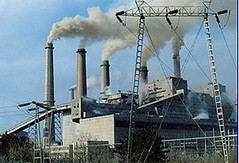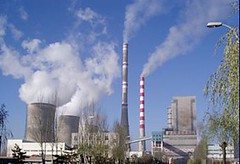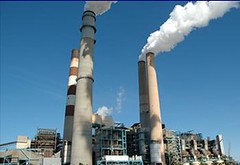 國際能源總署(IEA)9日於英國倫敦發表《2011世界能源展望》(2011 World Energy Outlook)報告時警告,除非「大幅度改變政策方向」,否則全球將會陷入不安全、效率低以及高耗碳的系統之中。
國際能源總署(IEA)9日於英國倫敦發表《2011世界能源展望》(2011 World Energy Outlook)報告時警告,除非「大幅度改變政策方向」,否則全球將會陷入不安全、效率低以及高耗碳的系統之中。
報告中指出,現在仍有時間採取行動,但是儘管已走在正確的方向上,機會之門卻越來越窄。
各國政府11月28日即將在南非德班舉辦的聯合國氣候變遷會議,國際能源總署發布這篇報告的時機,正好處於國際氣後談判的關鍵時刻。
國際能源總署首席經濟學家法提赫‧比羅爾(Fatih Birol)警告,「如果在2017年以前,我們沒有訂定有效的國際協議,機會之門將永遠關閉。」
國際能源總署總幹事范德胡芬(Maria van der Hoeven)表示,「政府應該要採取有力的措施來推動對高效與低碳科技的投資。」他接著說,「福島核能事故、中東與北非部分地區的動盪以及2010年對能源需求大幅反彈,使得二氧化碳的排放量達到歷史新高等因素,都凸顯出這個挑戰的規模與急迫性。」
能源總署指出,一些關鍵趨勢正朝向令人擔憂的方向發展。包括二氧化碳的排放量已達到新高,全球經濟的能源效率連兩年惡化,而對石油輸入的開銷則接近歷史最高紀錄。
《2011世界能源展望》報告中也提出關鍵的「新政策情境」分析,此假設情境的設定包括:各國政府以謹慎的態度實踐近來的承諾,而2010年至2035年間主要能源需求僅增加三分之一,並且讓非OECD國家(經濟合作暨發展組織以外的國家)仍維持經濟成長率達90%。在此情境下,《報告》預測,未來25年的二氧化碳累計排放量要比過去110年的總和減少1/4,使長期平均溫度升溫控制在3.5℃以內。
該報告認為,如果「新政策情境」沒有實現,我們將會在非常危險的情況下:平均溫度增加6℃。
 國際能源總署估計,中國將繼續保持全球最大能源消費國的地位。到2035年時,消耗的能源將超過美國70%。但即使如此,中國的人均消耗能源量仍不及美國人的一半。
國際能源總署估計,中國將繼續保持全球最大能源消費國的地位。到2035年時,消耗的能源將超過美國70%。但即使如此,中國的人均消耗能源量仍不及美國人的一半。
2035年時,石化燃料佔全球主要能源消耗的比例將從81%降至75%。
再生能源的比例,將從今日的13%增加到2035年的18%。再生能源的增長來自補助的增加,由2010年的640億美金提高到2035年的2500億美金。但在現今財政緊縮的時代下,某些情況可不是理所當然的──相比起來,2010年對石化燃料的補貼為4090億美金。
挑戰450ppm
 《2011世界能源展望》同時提出了一項「挑戰450情境」(450 Scenario),即限制大氣中溫室氣體濃度在450ppm以內,讓能源使用狀況控制在全球會議先前達成的共識:限制氣溫上升的幅度不超過工業革命前平均溫度的2℃以內。
《2011世界能源展望》同時提出了一項「挑戰450情境」(450 Scenario),即限制大氣中溫室氣體濃度在450ppm以內,讓能源使用狀況控制在全球會議先前達成的共識:限制氣溫上升的幅度不超過工業革命前平均溫度的2℃以內。
然而,該報告指出,根據「挑戰450情境」的設定,在2035年之前,為了限制二氧化碳排放而能使用的能源額度,有80%已經被既有的設施所佔去,包含發電廠、建築物與工廠等。所以若在2017年以前沒有進一步的行動,屆時所有與能源有關的基礎建設產生的二氧化碳量,將提早到達「挑戰450情境」所設定的2035年排放量。
「拖延是得不償失的,」比羅爾 警告,在2020年以前電力部門若少投資1美元在潔淨科技上,2020年以後就要多花4.3美元來彌補增加排放造成的問題。
《2011世界能源展望》報告的簡體中文版摘要可點此下載。
Unless there is a "bold change of policy direction," the world will lock itself into an insecure, inefficient and high-carbon energy system, the International Energy Agency warned at the launch of its 2011 World Energy Outlook today in London.
The report says there is still time to act, but despite steps in the right direction the door of opportunity is closing.
The agency's warning comes at a critical time in international climate change negotiations, as governments prepare for the annual UN climate summit in Durban, South Africa, from November 28.
"If we do not have an international agreement whose effect is put in place by 2017, then the door will be closed forever," IEA Chief Economist Fatih Birol warned today.
"Governments need to introduce stronger measures to drive investment in efficient and low-carbon technologies," she said.
"The Fukushima nuclear accident, the turmoil in parts of the Middle East and North Africa and a sharp rebound in energy demand in 2010 which pushed CO2 emissions to a record high, highlight the urgency and the scale of the challenge," van der Hoeven said.
Some key trends are pointing in worrying directions, the agency told reporters today. CO2 emissions have rebounded to a record high, the energy efficiency of global economy worsened for second straight year and spending on oil imports is near record highs.
In the World Energy Outlook's central New Policies Scenario, which assumes that recent government commitments are implemented in a cautious manner, primary energy demand increases by one-third between 2010 and 2035, with 90 percent of the growth in non-OECD economies.In the New Policies Scenario, cumulative carbon dioxide emissions over the next 25 years amount to three-quarters of the total from the past 110 years, leading to a long-term average temperature rise of 3.5 degrees C.
"Were the new policies not implemented, we are on an even more dangerous track, to an increase of six degrees C.
The IEA projects that China will consolidate its position as the world's largest energy consumer. It consumes nearly 70 percent more energy than the United States by 2035, even though, by then, per capita demand in China is still less than half the level in the United States.
The share of fossil fuels in global primary energy consumption falls from around 81 percent today to 75 percent in 2035.
Renewables increase from 13 percent of the mix today to 18 percent in 2035; the growth in renewables is underpinned by subsidies that rise from $64 billion in 2010 to $250 billion in 2035, support that in some cases cannot be taken for granted in this age of fiscal austerity.
By contrast, subsidies for fossil fuels amounted to $409 billion in 2010.
The World Energy Outlook also presents a 450 Scenario, which traces an energy path consistent with meeting the globally agreed goal of limiting the temperature rise to two degrees Celsuis above pre-industrial levels.
Four-fifths of the total energy-related CO2 emissions permitted to 2035 in the 450 Scenario are already locked in by existing capital stock, including power stations, buildings and factories, the report finds.
Without further action by 2017, the energy-related infrastructure then in place would generate all the CO2 emissions allowed in the 450 Scenario up to 2035.
"Delaying action is a false economy," Birol warned, saying that for every $1 of investment in cleaner technology that is avoided in the power sector before 2020, an additional $4.30 would need to be spent after 2020 to compensate for the increased emissions.







